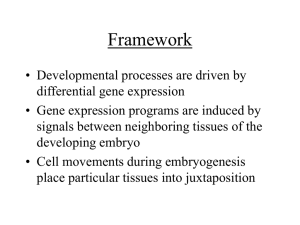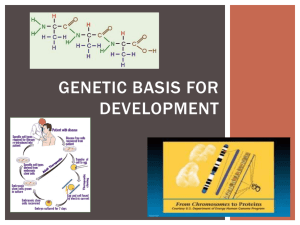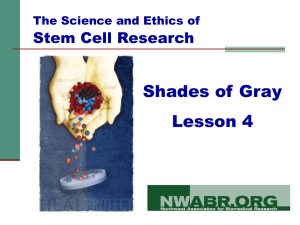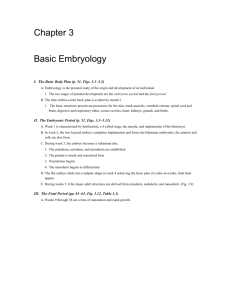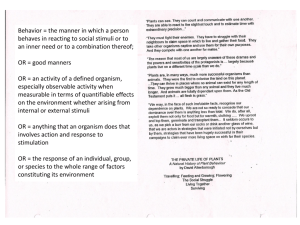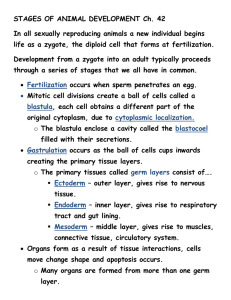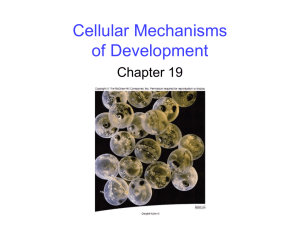Table of Contents
advertisement
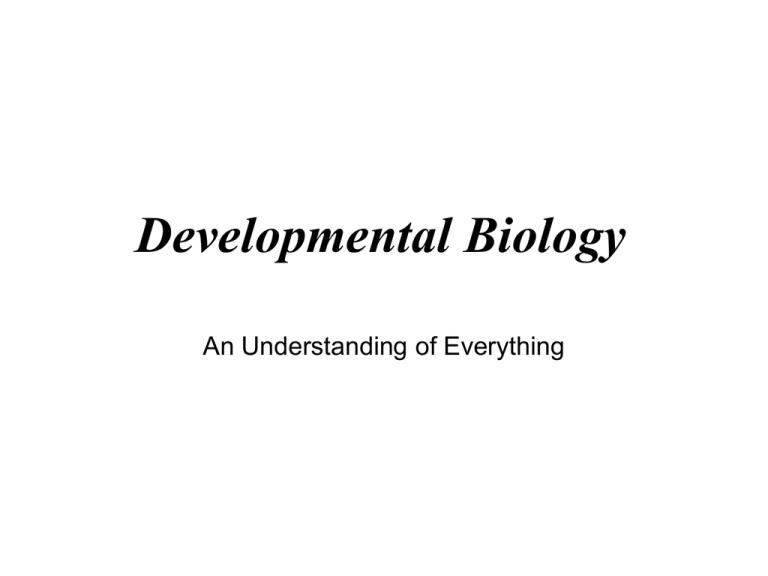
Developmental Biology An Understanding of Everything Stages & Events of Chordate Embryogenesis Developmental Process Embryonic Stage Zygote Morula Blastula Gastrula Neurulation Neurula Pharyngula Fetus Gametogenesis • Process of producing gametes Spermatogenesis Oogenesis • Meiotic cell division • Packaging of material into oocytes • Removal of cytoplasm from sperm Accumulation of Vitellogenin during Oogenesis in Xenopus Localization of Developmental Regulatory Factors • Dsh, Xcat-2, Xlsirt, Vg-1 mRNAs localized to vegetal pole of vertebrate eggs Xlsirt mRNA Bicoid Gradient in Drosophila Egg & Embryo Fertilization - Sperm and Egg Fusion Fertilization Induces a Rearrangement of Cytoplasmic, Localized Factors • Initial localization of material in eggs is radially symmetrical • Fertilization creates a point of asymmetry and causes rotational reorganization of cytoskeleton to generate bilateral symmetry Gray crescent Reorganization of Cytoplasmic Maternal Factors Set Up Signaling Cascades Figure 20.12 Molecular Mechanisms of the Primary Embryonic Organizer Cleavage Distributes Maternal Components to Blastomeres Figure 19.7 Asymmetry in the Early Embryo (Part 1) Figure 19.7 Asymmetry in the Early Embryo (Part 2) Autonomous Development of Separated Tunicate Blastomeres Figure 19.8 The Principle of Cytoplasmic Segregation Figure 20.10 Hans Spemann’s Early Experiments Figure 20.11 The Dorsal Lip Induces Embryonic Organization Fate Map of a Frog Blastula Figure 20.9 Gastrulation in the Frog Embryo (Part 1) Figure 20.9 Gastrulation in the Frog Embryo (Part 2) Figure 20.9 Gastrulation in the Frog Embryo (Part 3) Figure 20.15 Neurulation in the Frog Embryo (Part 1) Figure 20.15 Neurulation in the Frog Embryo (Part 2) Figure 20.13 Gastrulation in Amniotes (Part 1) Figure 20.13 Gastrulation in Amniotes (Part 2) Figure 20.16 The Development of Body Segmentation Mouse embryo Drosophila Homeotic and Vertebrate Hox Genes Control A-P Patterning Hox Genes Pattern A-P Axis Concepts in Developmental Biology • Polarity Established by localization of maternal gene products Established by inductive signaling events • Morphogenesis Cellular movements and embryonic structure formation Regulated by cell-signaling & cell adhesion mechanisms • Differentiation Specialization of cells to a particular fate • Growth Increase in cell number Increase in cell size Cell Specification • Differentiation The process and the processes associated with a cell becoming specialized Occurs in multiple steps Cell Specification • Autonomous All differentiation information is contained within the cell • Conditional Differentiation information supplied through interactions with other cells Cell Specification - Steps • Commitment Specification Determination • Terminal differentiation Cell Specification - Commitment • Specification A cell is said to be specified when: Cells differentiate autonomously when removed from normal environment (embryo) and placed in a neutral environment (culture medium) Placing cells into a non-neutral environment (a different place in the embryo) causes the cells to follow the fate of other cells the new location rather than their original fate Cell Specification - Committment • Determination A cell is said to be determined when: Cells differentiate autonomously even when placed in a non-neutral environment When moved to a different location within the embryo, the transplanted cells differentiate according to their original fate Cell Specification - Terminal Differentiation • When a cell can no longer change or be changed into anything other than the cell type it is • Can be associated with permanent changes in DNA DNA Methylation is a prominent factor B-cells (plasma cells) rearrange the immunoglobulin (Ig) genes so that they can now only form a single type of Ig Spemann’s Specification Experiments Inductive signals trigger conditional specification, determination and differentiation Presumptive neural plate ectoderm in the early gastrula was uncommitted. Later gastrula neuroectoderm was committed to a neural fate. Dorsal Lip Transplantation Reversal of Terminal Differentiation • Embryonic Stem cells Totipotent or pluripotent cells • Dedifferentiated stem cells Pluripotent Derived from previously differentiated cells • Cloning proves nuclear equivalence Figure 19.3 Cloning a Plant (Part 1) Cloning by Nuclear Transplantation • Nuclear transplant experiments have shown that somatic cells contain the entire genome. • Nucleus of an unfertilized egg is replaced with the nucleus of a somatic cell • These experiments led to two important conclusions: No information is lost in the early stages of embryonic development (a principle known as genomic equivalence). The cytoplasmic environment around a nucleus can modify its fate. The First Cloning Experiment – Nuclear Transplantation in Xenopus laevis Cloning of the frog Xenopus laevis by nuclear transplantation of albino gut cell nuclei into enucleated, wt oocytes. All progeny are albino & female tadpole oocyte nucleus First Mammalian Clone Dolly & Bonnie Figure 19.10 Induction during Vulval Development in C. elegans (Part 1) Figure 19.10 Induction during Vulval Development in C. elegans (Part 2) A Gene Cascade Controls Pattern Formation in the Drosophila Embryo Maternal effect genes Gap genes Pair rule genes Segment polarity genes Homeotic genes Bicoid and Nanos Protein Gradients Provide Positional Information (Part 1) Figure 19.14 Bicoid and Nanos Protein Gradients Provide Positional Information (Part 2) Figure 19.16 A Homeotic Mutation in Drosophila Antennapedia Figure 19.12 Organ Identity Genes in Arabidopsis Flowers (Part 1) Figure 19.12 Organ Identity Genes in Arabidopsis Flowers (Part 2) Figure 19.13 A Nonflowering Mutant Northern Analysis: Gel Electrophoresis Formaldehyde gels Methyl-mercury-OH gels Northern Analysis: Probing Spatial expression information RNA Localization Developmental Stages temporal expression information


